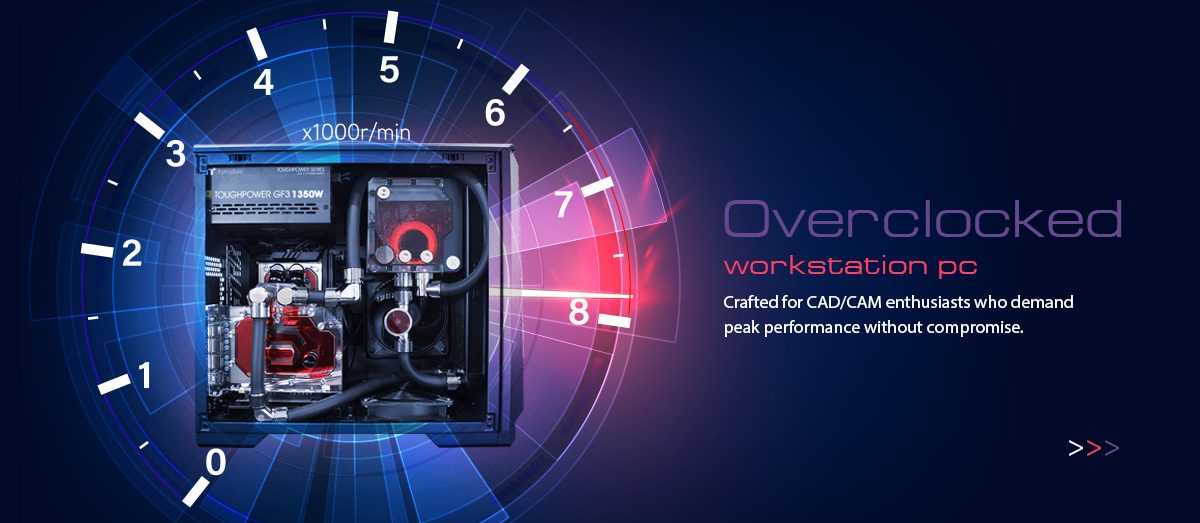Designing the Perfect Workstation for AutoCAD
AutoCAD is one of the most important pieces of professional
software in the world. No matter who you are, it’s almost certain that
something you’ve used has at one point been an AutoCAD design.
Despite this, AutoCAD isn’t the most demanding software in
the professional world, and so we’ve found that for dedicated AutoCAD
workstations (that won’t be running anything else) customers tend to overspend
on their systems. Remember, workstations aren’t just about performance, but
about reliability and quality too! So let’s take a frank look at what you
really need in an AutoCAD workstation.
AutoCAD Workstations Designed Just for You:
Processor
Power: The Heart of Your Workstation PC
Despite being so visual in nature, AutoCAD is actually
largely a CPU-based program. No only that, it’s not particularly multi-threaded
either. Most of what AutoCAD usually does during your workflow is
single-threaded and so performance is limited by how fast that single core can
go.
This is why it’s better to aim for CPUs with a more
moderate core count, but with high boost clocks. For example. The 14600K has
six high-performance cores and eight efficiency cores. The performance cores
will go over 5Ghz in single-threaded workloads, offering snappy CAD
performance, without the added expense of more performance cores that don’t add
to CAD’s performance.
The one major exception is Mental Ray rendering, which will
take as many cores as you’ll throw at it, but in that case having those extra
efficiency cores in our example CPU would still help.

However, it’s not good practice to have your rendering
workstation and design workstation be the same. Instead, talk to us about a
dedicated rendering workstation, so that your renders can happen without
interrupting your design work.
We don’t recommend Xeon CPUs for CAD any longer, since
these days Intel’s consumer chips work just as well for CAD and can achieve
higher clock speeds. So you can save money and have a better overall
experience.
Autodesk
and GPUs
If all you ever work on are 2D designs, you can get by with
the most entry-level professional graphics cards we offer.
However, we do strongly recommend you use a workstation
class GPU such as an NVIDIA Quadro or RTX 4000 series GPU. This is because of
the stringent driver verification, ensuring that you don’t get any nasty
surprises when you output you final design.
If you are going to do mainly 3D design in AutoCAD, then
those same entry-level cards should do just fine. AutoCAD isn’t particularly
VRAM hungry, and its real-time 3D views also don’t require a fancy GPU.
AutoCAD
RAM Needs
Just as with most of its requirements, AutoCAD doesn’t need
a lot of RAM to run well. The recommended amount by AutoDesk is a mere 8GB.
However, we wouldn’t recommend less than 16GB for any computer, much less a
workstation. After all, your system may still have to run other software such
as web browsers or productivity apps and email in the background.
RAM is relatively affordable, so if your budget can stretch
to it, we recommend 32GB for most customers.
AutoCad Storage
Requirements
Again, when it comes to AutoCAD our recommendations around
storage are the same as they are for any computer running any software today.
Run your operating system and AutoCAD on a fast NVME SSD. If your budget
allows, a second dedicated SSD for your project files is a good idea, but in a
pinch you can have it all on a single SSD and just ensure that you have good
backup habits.
Give Us
a Call
We’ve helped hundreds of AutoCAD users over the years to
find the perfect balance of budget and performance for their needs. The more we
know about your work, the better we can assist you. So give us a call and a
consultant will help you spec the right AutoCAD workstation for the scope of
your specific projects.
LIST OF COMPATIBLE WORKSTATIONS:
|